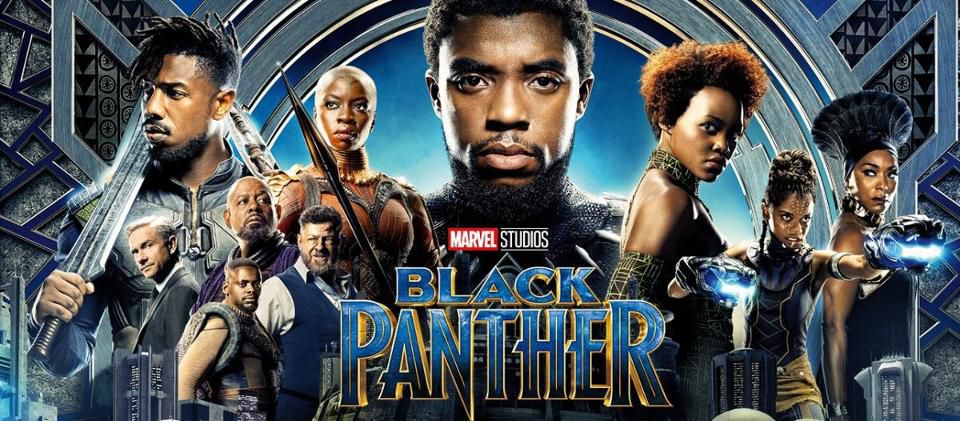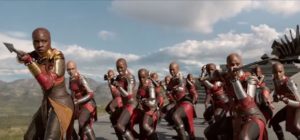Black Panther: Wakanda Forever
Posted on November 8, 2022 at 12:20 pm
A-| Lowest Recommended Age: | Middle School |
| MPAA Rating: | Rated PG-13 for sequences of strong violence, action, and some language |
| Profanity: | Some strong language |
| Alcohol/ Drugs: | Fantasy potion |
| Violence/ Scariness: | Extended and intense comic-book/fantasy peril and violence, very sad deaths, characters injured and killed |
| Diversity Issues: | A theme of the movie |
| Date Released to Theaters: | November 11, 2022 |
| Date Released to DVD: | February 6, 2023 |

The sequel to “Black Panther,” like the original, begins with the death of the king. We may think we were prepared for this. We have had two years to mourn Chadwick Boseman, whose instantly iconic portrayal of the title character was powerfully dignified, courageous, dedicated to his people, and yet endearingly vulnerable. Remember how overcome he was by Nakia (Lupita Nyong’o). But in the first moments of “Black Panther: Wakanda Forever,” we see Queen Ramonda (a fiercely fiery Angela Bassett) and her scientist/engineer daughter Suri (Letitia Wright) shocked and devastated by the death of their son and brother, King T’Challa, of some unstated illness. Suri had frantically tried to create a synthetic version of the vibranium-infused “heart-shaped herb” that might have been able to heal him. And so, their grief is deepened by a sense of failure. His loss is the end of the Black Panther line because only the herb could grant the superpower strength and agility.
It is clear, though, that it is not just the characters who are in mourning but the actors and the filmmakers, who give Boseman a most loving tribute. Like the people of Wakanda, we have lost a rare and treasured member of our community who had so much more to give us. This is a comic book movie with a lot of tears on screen and I predict a lot in the audience as well.
A year after T’Challa’s death, the queen has taken over as the leader of Wakanda. She appears before a UN panel who accuse her of not living up to her country’s promise to share the extraordinary properties of vibranium, which is found only in their country and is the basis for their extraordinary technology. She tells them that they have shown they will abuse the mineral by adapting it for offensive weapons. She is withholding it, “not for the dangerous nature of vibranium, but for the dangerous nature of you.”
Predictably, the world powers were not going to wait for Queen Ramonda to decide to share vibranium. The US has a vibranium detecting machine — just one — that has located some on the ocean floor. The leader of the previously unknown vibranium-based underwater country is Namor (Tenoch Huerta). He appears before Queen Ramunda with a threat — if she does not Find and kill the inventor of the machine that can find vibranium, he will attack Wakanda.
It is a shock to the exceptionalism of Wakanda’s identity to disco ver that vibranium not only exists in other place; it has also been the basis for an advanced civilization. And they are more protective, even aggressive, in keeping out intruders. Like the first film, which popularized the term “colonizer” as an insult, this film is grounded in the trauma of centuries of plunder and abuse. It lends the series a gravity that makes even the most fanciful elements more meaningful.
Suri and the General of the Wakanda army, Okoye (Danai Gurira) find the inventor, an MIT undergraduate Marvel comic fans will recognize as Riri Williams (Dominique Thorne). She is, like Suri, an engineering genius. And she has a gift for skunkworks machines made from a combination of junkyard finds and uniquely crafted designs. Namor and the Wakandans are not the only people who want the creator of the machine. This leads to a wild chase scene through the streets of Boston, and to both girls being taken to Namor’s Talokan. Suri is curious to learn as much as possible about Talokan. And she is determined to protect Riri.
The movie’s visuals are stunning, wildly imaginative but within the realm of possibility and always gorgeous. Production designer Hannah Beachler, who has worked with writer/director Ryan Coogler since “Fruitvale Station,” and Ruth E. Carter, who was awarded a well-deserved Oscar for “Black Panther’s” costumes, have outdone themselves with one jaw-drooping image after another, always in service of the story. Queen Ramona’s jewelry and costumes match Bassett’s powerful dignity and resolve. The people of Talokan reflect the indigenous designs of South America. Every single time they appear out of the ocean, it is goosebump-inducing. The titles informing us of the locations begin with the native lettering, and then are translated into English, underscoring the respect for the cultures being portrayed, refusing to “other” them.
As I have observed many times before, superhero movies depend, more than the powers of their heroes, on the motives and personality of their villains. Eric Killmonger, played by Michael B. Jordan in the first film, is, in my opinion, the best Marvel villain of all time. Huerta’s Namor is also a top-level villain, willing to do whatever it takes to protect his people, still furious over what happened to them when they still lived on the land. His conflicts parallel Suri’s, making the dynamic between them more meaningful. Where does justice end and vengeance begin? Is it possible to have one without the other?
This is a movie about the Wakandan women. Winston Duke’s M’Baku and CIA Wakanda expert Ross (Martin Freeman) play important supporting roles, but it is Queen Ramunda, Suri, Okoye, Nokia, and Riri who are at the center of this story. Their interaction, with good will and often good humor (the comments about the dress presented to Shuri by the Talokans is a hoot) is the vibranium that is this film’s superpawer.
Of course there is also that wow of a chase scene and terrific comic-book action. There are some flaws — too much backstory, and the whole idea that killing the inventor would prevent any further efforts to locate more of the world’s most precious substance — but this is a movie that would make T’Challa proud, and it is a worthy tribute to Boseman and to the Marvel writers and artists who first envisioned Wakanda and made us all want it to go on forever.
Parents should know that this movie has intense comic-book peril and violence with characters injured and killed and some painful deaths of family members. Characters use brief fstrong language and there is a non-explicit scene of childbirth.
Family discussion: How are Namor and Suri alike? How are they different? What should Wakanda do about sharing vibranium?
If you like this, try; “Black Panther” and the comic books






